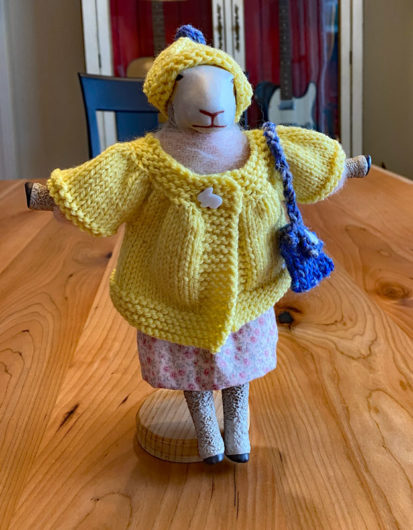 If you’ve visited here before you probably already know my guilty pleasure: cotton cloths. Especially Amy Marie Vold’s mosaic cloths. I’ve always enjoyed mosaic a/k/a slip stitch work. I enjoy using the cloths. Oh heck, why hide out? Dishcloths. They aren’t just cloths. I don’t use them as facecloths. And calling them spa cloths is just some kind of affectation.
If you’ve visited here before you probably already know my guilty pleasure: cotton cloths. Especially Amy Marie Vold’s mosaic cloths. I’ve always enjoyed mosaic a/k/a slip stitch work. I enjoy using the cloths. Oh heck, why hide out? Dishcloths. They aren’t just cloths. I don’t use them as facecloths. And calling them spa cloths is just some kind of affectation.
I like to knit dishcloths. Yep, the stuff that lots of knitters see as a total waste of the not-infinite number of lifetime wrist and finger twists we’re entitled to before we end up with carpel tunnel or knitters’ elbow. What also encourages me is that some folks in my neck of the woods who don’t have any interest in small accessories like hats (“I don’t wear hats”), scarves (“I just zip up my coat”), mittens (“I only wear gloves”), fingerless mitts (“doesn’t that just mean cold fingers”) or cowls (“what’s a cowl”), give an enthusiastic “yes” to dishcloths.
These worsted weight star cloths are Amy Marie’s “Washing with the Stars” pattern. I very much enjoyed knitting them. I was surprised that DROPS Paris in strong yellow and dusty rose worked well together. They beat a quick retreat from my door during my holiday pick-your-gift-along.
Not long before the holidays I decided to knit a dishtowel to gift a fellow knitter. I’d had my eye on Amy Marie’s DK weight cotton towel Beeline Towel from her Bee Colony ebook for a few months. While on a knitting retreat I picked up some Ella Rae Phoenix DK. Yellow and black yarn would have been a better contrast, but black yarn and I don’t play nice anymore. Even if I work on light-colored needles and under a bright light I still struggle. So, my Beeline is yellow and gray.
Very sweet.
I’d not worked with Phoenix DK before. It’s probably not going to be a favorite yarn. It’s got a bit of shine to it that I’m not thrilled with. I washed and dried the cloth before gifting it because I didn’t want to give my friend a towel that couldn’t hold up to the washer and the dryer. It developed a few ruffles on the cast on and bind off edge but otherwise did remarkably well.
I had enough yarn left lover to knit up another of Amy Marie’s DK weight cloths: “The Dishscraper That Never Sleeps.”
The city at night is great fun to knit. And you can reverse the colors and knit the daytime city. As you can see, my gray cotton definitely has a bluish tinge to it–though not so much as the night sky pictured here seems to show.
This next set is the Shore Lunch Cloth, knit here in Lily Sugar ‘n Cream worsted:
Shore Lunch is a big fav. I think it’s something about knitting those bones. Plus I do have some fisherpeople in my clan.
This next pair is from Amy Marie’s Balloon Rides pattern. The pattern allows you to pick one of six motifs to knit in the mid-section of the balloon. My set is knit in the dishcloth workhorse, Lily Sugar ‘n Cream. A friend with red countertops in her kitchen was very pleased to receive these.

I usually follow Amy Marie’s directions to use the so-called “Chinese Waitress” cast-on, so named by Cap Sease (author of Cast-On, Bind-Off) who learned it from a friend who learned it from a Chinese waitress. Here’s a link to Cap demonstrating it, in case you haven’t seen that cast-on. It makes for an interesting crochet-like chain start. Until you get the hang of it it’s a bit fiddly. And the perfect match as you end is the double-chain bind-off that Ann Kingstone demonstrates here.
That’s something else about knitting dishcloths. With such a small investment of time and materials, a knitter can try out new techniques with very little risk to purse or ego.
I should have re-watched Cap’s cast-on video before I started these next dishcloths. They are Amy Marie’s Chameleon Snowflake Poinsettia cloths. Chinese Waitress cast-on? My head and my hands know that one. No problem. Hmmm. I should have heeded Han Solo’s “Don’t get cocky, kid” admonition. I knit the cast-on wrong and somehow managed a sort of double-wide version. The cloths were still very festive though. I always keep the mistake-afflicted ones. Don’t feel sorry for me. I also have quite the collection of no-mistake cloths.






















